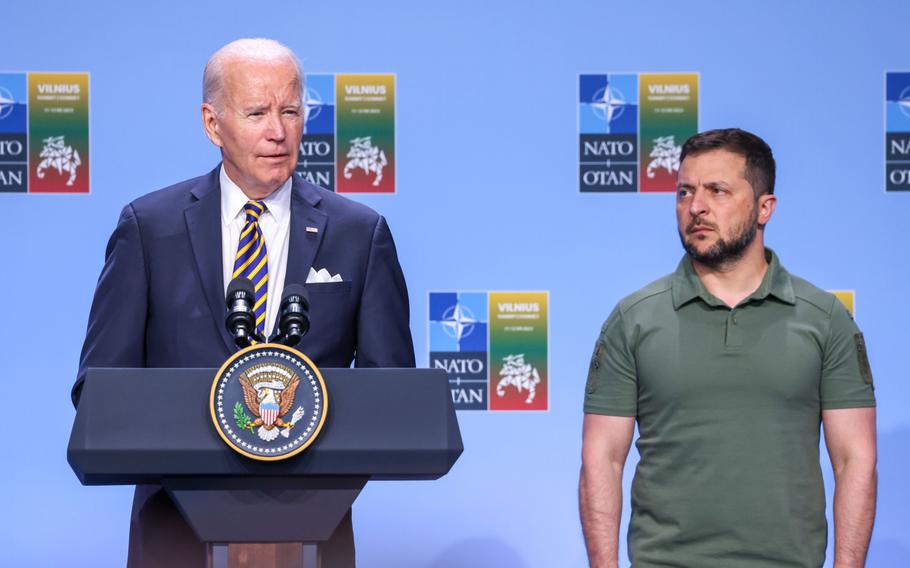
President Joe Biden and Ukrainian President Volodymyr Zelenskyy on the closing day of the NATO summit in Vilnius, Lithuania, on July 12, 2023. (Andrey Rudakov/Bloomberg)
President Joe Biden’s trip to Europe for the NATO summit in Vilnius, Lithuania, this week was not just routine, given Russia’s invasion of Ukraine. Biden first stopped in Britain, underscoring our special relationship. The last stop was Finland, NATO’s newest member.
When Britain’s Prime Minister Rishi Sunak recently visited the United States, some criticized the absence of a state dinner. However, Britain became part of our trans-Atlantic family in World War II. Formalities are not required.
Early in that war, Finland’s military fought invading much larger Soviet forces to a draw.
The eve of the summit brought significant news: Turkey’s opposition to Sweden joining the alliance has ended.
Agreement was confirmed that Ukraine can join NATO, but not right away. This is wise, since the current Russia-Ukraine war could more easily escalate to involve the entire alliance. Nuclear weapon states would be direct combatants, including Britain and France along with Russia and the United States.
NATO is a remarkably durable alliance. Nations led by the United States and Britain signed the NATO treaty in Washington in April 1949. By contrast, alliances lasted on average only five years during the long Napoleonic wars of two centuries ago.
Our present alliance began in direct response to Soviet expansionism during and after World War II. By 1949, the Cold War was on. Today, the organization pursues various diverse missions, including humanitarian relief.
The collapse of East Europe communist regimes, followed by the Soviet Union, ended the Cold War but not conflict in Europe. In 2008, Russian troops invaded a portion of Georgia, following an attack by Georgian troops on South Ossetia. Russia encouraged and fostered these breakaway efforts. In 2014, Russia intervened in eastern Ukraine and annexed the territory of Crimea.
Conclusion of the Cold War was a great victory for the policy of restraint and deterrence, termed “Containment.” Every U.S. president from Harry Truman, when the Cold War commenced, to George H.W. Bush, when that conflict ended, supported this foundation security policy.
NATO endured for various reasons. Bureaucracies instinctively seek self-perpetuation, and modern militaries represent potent political lobbies. However, the strategic realities of a now dangerously aggressive, expansionist Russia under President Vladimir Putin are the most important incentive and have reenergized the alliance.
Putin continually probes for ways to separate allies from the U.S. Also present is the danger of renewed violence among ethnic groups in Southeastern Europe.
NATO today has a range of missions including but going beyond self-defense narrowly defined. Forces have operated well beyond the North Atlantic region, including notably in Afghanistan. Humanitarian work has included transport and other support missions during the COVID-19 pandemic.
This in turn opens the door to a range of positive and productive activities beyond traditional military defense and security. With further expansion of economic development in Eastern Europe, the Middle East, North Africa and more widely, demand for better education, health care and related humanitarian activities also will grow.
This could lead to further development of the alliance’s capacities and involvement beyond purely military dimensions.
Article 5 of the NATO treaty states that an attack on one member nation is an attack on all. The 9/11 terrorist strikes on New York and the Pentagon, and in the sky over Pennsylvania, triggered this clause, for the first time.
After final defeat of Napoleon, Britain spearheaded cooperation among Europe’s nations to keep the peace. This maintained general stability on the continent for a century.
Today, NATO performs roughly the same strategic role. The Russia-Ukraine war provides a different test, not the relative stability of the long Cold War.
The Vilnius summit provides one gauge for evaluation.
Learn More: Henry A. Kissinger, “The Troubled Partnership” and his other books.
Arthur I. Cyr is author of “After the Cold War.”